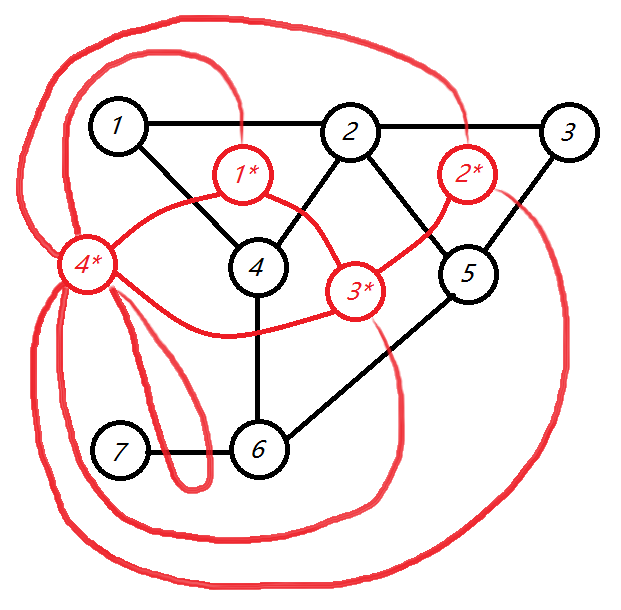【bzoj1001】【最短路】【对偶图】【最大流转最小割】狼抓兔子题解
【BZOJ1001】狼抓兔子
1001: [BeiJing2006]狼抓兔子
Time Limit: 15 Sec Memory Limit: 162 MBSubmit: 18872 Solved: 4647
[Submit][Status][Discuss]
Description

Input
Output
输出一个整数,表示参与伏击的狼的最小数量.
Sample Input
5 6 4
4 3 1
7 5 3
5 6 7 8
8 7 6 5
5 5 5
6 6 6
题目大意:如和将一张无向图割成完全不相连的两部分,并使被割的边总权值最小。
题解:刚看这道题的时候满脑子暴力,直到某大佬让我去学学对偶图然后给我说这是最短路问题后,才渐渐开始有了思路。在进入正题前我们得先了解对偶图是啥。
维基百科对对偶图(Dual Graph)的解释如下:
“In the mathematical discipline of graph theory, the dual graph of a plane graph G is a graph that has a vertex for each face of G. The dual graph has an edge whenever two faces of G are separated from each other by an edge, and a self-loop when the same face appears on both sides of an edge. Thus, each edge e of G has a corresponding dual edge, whose endpoints are the dual vertices corresponding to the faces on either side of e. The definition of the dual depends on the choice of embedding of the graph G, so it is a property of plane graphs (graphs that are already embedded in the plane) rather than planar graphs (graphs that may be embedded but for which the embedding is not yet known).”
根据维基百科的解释,对偶图中的每一个点即为平面图中的某一个面,对偶图中任意两点间的线都是平面图中对应两平面公共边的割线,如果平面图中某一条边只属于一个面,那么在对偶图中就是一个环边,注意平面图周围无边界的面也是对偶图中的一个点。
首先这是一个普通的平面图:

此平面图对应的对偶图即为:

如图所示,对偶图的边数等于平面图的边数,对偶图的点数等于平面图的面数。
那么对偶图和这道题又有什么关系呢?
首先我们把起点和终点不与其他边交叉地连接起来构成一个新面,然后做出这个新平面图的对偶图,把对偶图中新面的点和无边界面的点之间的连线删去,求新面的点到无边界面的点的最短路即可(注意割线的权值即为被割边的权值)。这样求得的最短路就是原平面图的最小割。如下图所示(图源自网络):
这样我们就可以将最大流问题转化为一个最小割问题,也就可以当成是最短路问题了。所以到这里这道题唯一的难点就在输入时处理平面图和对偶图并加边上了,用数学推导推导就好了,这里不再赘述。
下面贴AC代码:
1 #include <cstdio> 2 int N,M,cnt,end_pos,minn=1e9,star,ass,t; 3 int pre[2000000],dist[2000000],quq[2000000];//bzoj数据有毒,随意开上几百万别MLE了就行 4 bool vis[2000000];//最好别用int存,有可能超内存或者开内存的时候超时什么的 5 struct pack {int to,next,len;} E[6000000]; 6 void add_edge(int x,int y,int v){ 7 E[++cnt].to=x;E[cnt].next=pre[y];E[cnt].len=v;pre[y]=cnt; 8 E[++cnt].to=y;E[cnt].next=pre[x];E[cnt].len=v;pre[x]=cnt; 9 } 10 int spfa(){ 11 while (star<=ass) 12 { 13 int x=quq[star]; 14 vis[quq[star++]]=false; 15 for (int i=pre[x];i!=0;i=E[i].next) 16 { 17 int y=E[i].to; 18 if (dist[y]>dist[x]+E[i].len) 19 { 20 dist[y]=dist[x]+E[i].len; 21 if (vis[y]==false) 22 { 23 quq[++ass]=y; 24 vis[y]=true; 25 } 26 } 27 } 28 } 29 } 30 void input_adt(){ 31 scanf("%d%d",&N,&M); end_pos=2*(N-1)*(M-1)+1; 32 if(N==1){ 33 for(int i=1;i<M;++i){ 34 scanf("%d",&t); 35 if(t<minn) minn=t; 36 } 37 return ; 38 } 39 else if(M==1){ 40 for(int i=1;i<N;++i){ 41 scanf("%d",&t); 42 if(t<minn) minn=t; 43 } 44 return ; 45 } 46 47 48 for(int i=1;i<=end_pos;++i) dist[i]=1e9; 49 50 51 for(int i=1;i<=2*(N-1)+1;i+=2) 52 for(int j=1;j<M;++j){ 53 scanf("%d",&t); 54 /* if(N==1){ 55 if(t<minn) minn=t; 56 }*/ 57 if(i==1) add_edge(j,0,t); 58 else if(i==2*(N-1)+1) add_edge(end_pos-(M-j),end_pos,t); 59 else add_edge((i-2)*(M-1)+j,(i-1)*(M-1)+j,t); 60 } 61 // if(minn!=1e9) return ; 62 63 64 for(int i=1;i<2*(N-1)+1;i+=2) 65 for(int j=1;j<=M;++j){ 66 scanf("%d",&t); 67 /* if(M==1){ 68 if(t<minn) minn=t; 69 }*/ 70 if(j==1) add_edge(i*(M-1)+1,end_pos,t); 71 else if(j==M) add_edge(i*(M-1),0,t); 72 else add_edge(i*(M-1)+j,(i-1)*(M-1)+j-1,t); 73 } 74 // if(minn!=1e9) return ; 75 76 77 for(int i=1;i<2*(N-1)+1;i+=2) 78 for(int j=1;j<M;++j){ 79 scanf("%d",&t); 80 add_edge((i-1)*(M-1)+j,i*(M-1)+j,t); 81 } 82 } 83 int main(){ 84 input_adt(); 85 if(minn==1e9){ 86 spfa(); 87 printf("%d",dist[end_pos]); 88 } 89 else printf("%d",minn); 90 return 0; 91 }



